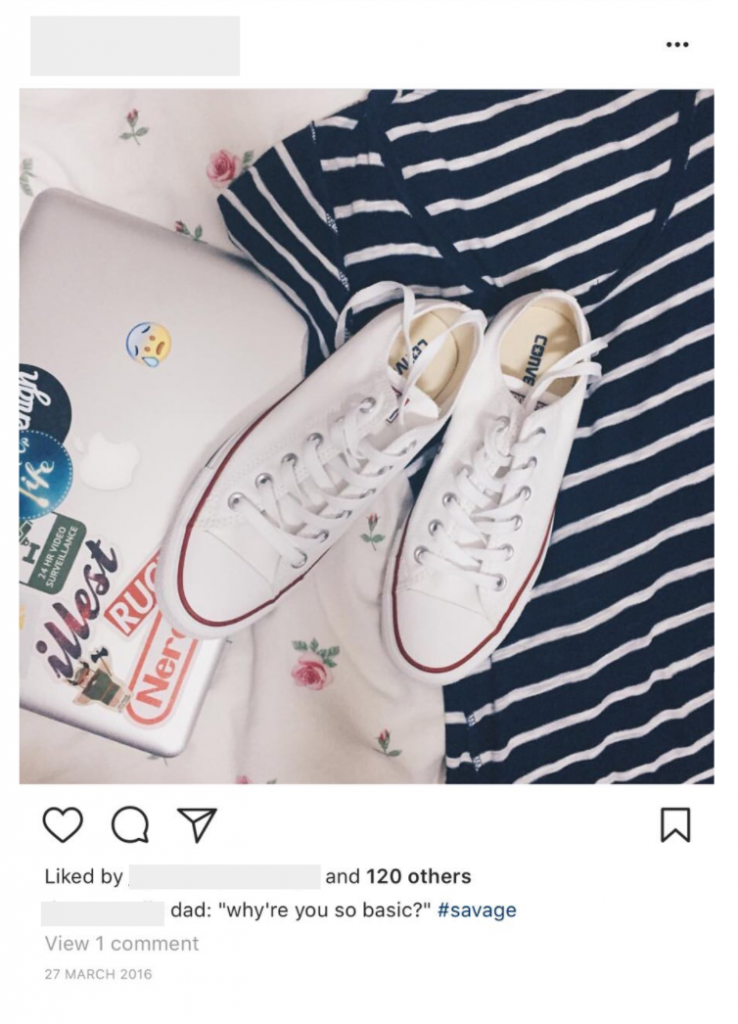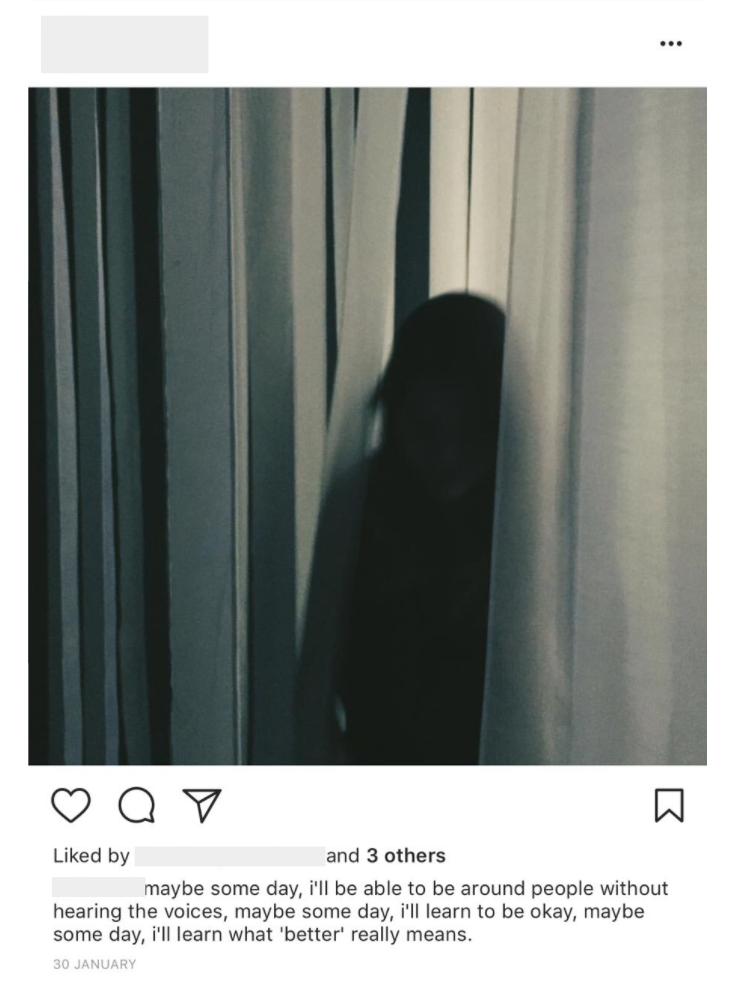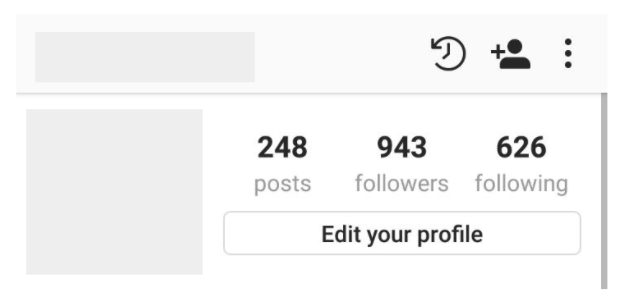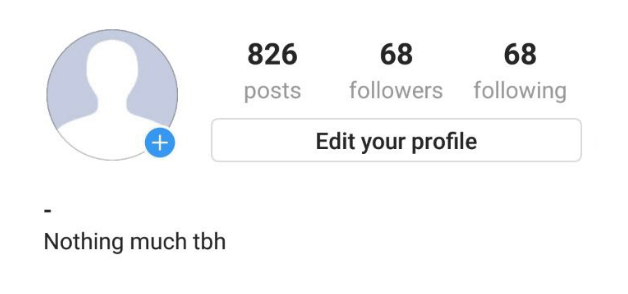Finstagram, or Finsta for short: derived from the unimaginative combination of the words ‘Fake’ and ‘Instagram’
Finstagrams from across the world, including Singapore, all share a few common traits. They’re private and a secret (hence ‘fake’) and usually owned by girls. They have low follower counts, usually peaking at mid-double digits, and often sport what some would call an “unaesthetic” looking feed.
Depending on the kind of Instagrammer you are, your Rinstagram might typically feature a carefully curated selection of pictures and videos detailing life’s better or more #aesthetic moments. Your Finsta on the other hand, is likely to tell a different, unfiltered, and arguably more true-to-life story.
In other words, it’s where the unglamourous/wacky/over-thinking/insecure/annoying side of you gets to shine.
So why do people do it?
on Finstagram, they share intimate and unadulterated snapshots of their lives otherwise filtered out on main accounts
“Everybody started upping their game. Feeds became more curated and aesthetic. That’s when it crossed my mind that Instagram no longer feels genuine,” he observed.
Kirsten, 23, shares similar thoughts: “It was starting to feel increasingly fake. My main account was getting too curated. I was using the same presets on VSCO where the contrast has to be this much and the fade this much. There was a certain pressure to come up with good captions or look cool. I felt like I couldn’t express myself in different ways.”
The answer to Instagram’s lack of real-ness was, ironically, to create a fake Instagram.
Tired of adhering to the strict and self-imposed parameters applied to their Rinstagrams, millennials like Philip and Kirsten are increasingly turning to Finstas. For Kirsten, this is where she can post multiple, unedited pictures straight from her photo album, whereas Philip takes pride in uploading memes and pictures of his cross-eyed, double-chinned selfies.
On Finstagram, they shed their inhibitions, sharing intimate and unadulterated snapshots of their lives that would otherwise be filtered out on their main accounts.
Yet all this begs the question: If you’ve already got a Finstagram, why still bother with a main account? Why not just get rid of it?




Yet main accounts are still valuable. For Kirsten, it’s because “my main account holds 4 years worth of memories more than my Finsta.”
She adds, “I don’t regret anything that I’ve posted on there.”
For Andrew, 25, another Finsta user, his main account functions more like a gallery: “It’s aesthetically pleasing, similar toned, has no emotional links and no faces. It’s something that I can look through and be happy with.”

Lydia hit one of the lowest points in her life when she was 19, having struggled with depression and anxiety. With over 1000 followers on her main account, and afraid of the stigma surrounding mental health, she turned to her Finsta.
“I wasn’t ready to express myself verbally with anyone. When I started my Finsta, I didn’t follow anyone and nobody followed me. I didn’t want to burden everyone with my thoughts and concerns—the negative ones at least. Here, I could let everything out. It was my safe space where I could express my deepest thoughts.”
Lydia credits her Finstagram for helping her articulate what she was going through in her head. When she eventually began opening up to both her friends and a therapist, it was her Finsta that helped them better understand what she had been going through.
That was two years ago. Although she still continues to battle depression, she’s no longer alone. 38 of Lydia’s close friends, those that she “trusts and confides in,” are followers on her Finstagram.
“They understand how I feel and they know what to expect,” she says.


Although a larger following is usually desirable on Rinstagram, the opposite is true for Finsta. Some Finsta users I spoke to had as little as 20 to 30 followers whereas their Rinstagrams had over 3000 followers.
A smaller, select group of close followers is key to making Finstas work as a trusted audience makes users feel safer and thus emboldened to share more personal moments.
At the same time, this trust can easily be broken.
Finsta-snitches, as Western media outlets term them, are the social media equivalent of back-stabbers and double crossers. They’re people who leak (with screenshots or showing and telling) private Finsta content to non-followers.
From time to time, Philip, in his own words, “gets bitter” and uses his Finsta to diss people by posting screenshots of their conversations online: “There have been a few instances where the person found out and I got into trouble for it. But at the end of the day, you’re able to easily trace who leaked it and just cut them off.”
Amanda, 20, an ex-Finsta user, deleted her account after the things she posted on her Finsta were leaked. “I let people who I thought I could trust follow my private account. But even after I kept my circle of followers so small, people still were talking shit about the things I posted on it.”
Seeing no point in maintaining a private account, she eventually decided to take it down.
Sadly, Finsta-snitches fail to respect the unspoken rules of confidentiality.
While it may be naive to expect complete secrecy on what is after all, a social media platform, the fact that Finsta posts may be morally or socially ‘unacceptable’ makes it all the more important that its contents stay private.
I guess the only silver lining to this is that by weeding out the Finsta-snitches, users will finally know who their true friends are. Personally, I believe there exists a special place in hell just for Finsta-snitches.


Andrew finds that he still has to filter himself: “I hesitate when talking about even more frustrating and less PC (politically correct) thoughts. Although my Finsta is much less censored than my main account, I find myself still trying to please some people.”
It is for this reason that Andrew has not one, but two Finsta accounts. His first Finsta was started in August of 2016 while the second was created after he got together with his current boyfriend.
“Even though the people on my second account know of my sexuality, I didn’t want to post too many things about my boyfriend and I. I’m afraid it might be too ‘in your face’. So to minimise that, I have a third account just for the two of us.”
The same rings true for Kirsten. She started her Finsta with 15 followers but soon found that she “wasn’t getting the likes” she wanted and “sort of missed that part of it”. Before she knew it, her follower count shot up to over a hundred people.
“The more people I followed, the more censored I was. I started feeling a little judged and more self conscious. I was posting less and less, because even though it’s private, my Finsta still reflects upon how I present myself.”

Scrolling through the Finstagram feeds of some of my friends, I can’t help but be reminded of the days where personal blogs on LiveJournal and Blogspot were all the rage.
In fact, apart from the platform, whether blog or photo-sharing app, the same use of lengthy paragraphs and pictures shows that not much has changed over the last ten years. Then and now, we still have to negotiate between privacy and personal branding.
But as we know by now, Finstas are not a perfect solution. The very fact that they live in the same space as Rinstas, separated only by a push of a button, makes it so that we’re ultimately still subject to the same impulses on both accounts. You might know that you have less followers on your Finsta, but the lack of likes can still be galling.
So could it perhaps be time to re-evaluate and ask ourselves who or what we’re using Finstagram for? Are we doing it for others, or for ourselves? If it’s the latter, then stay. But if it’s the former, then maybe we need to start looking elsewhere for the privacy and authenticity we so crave.






